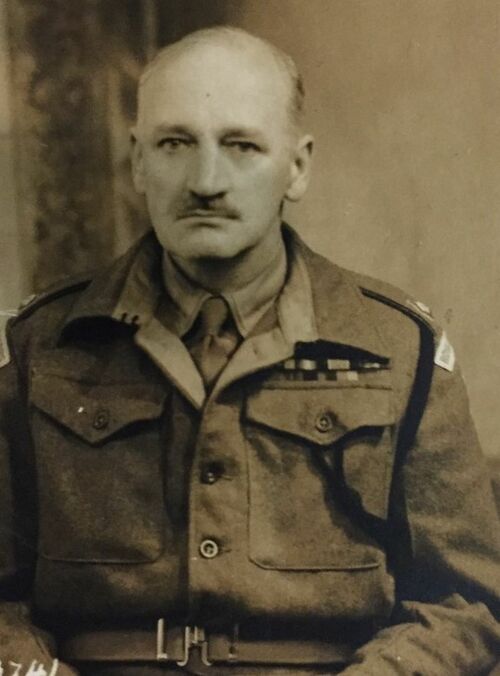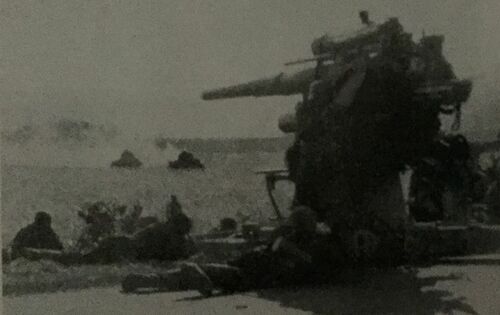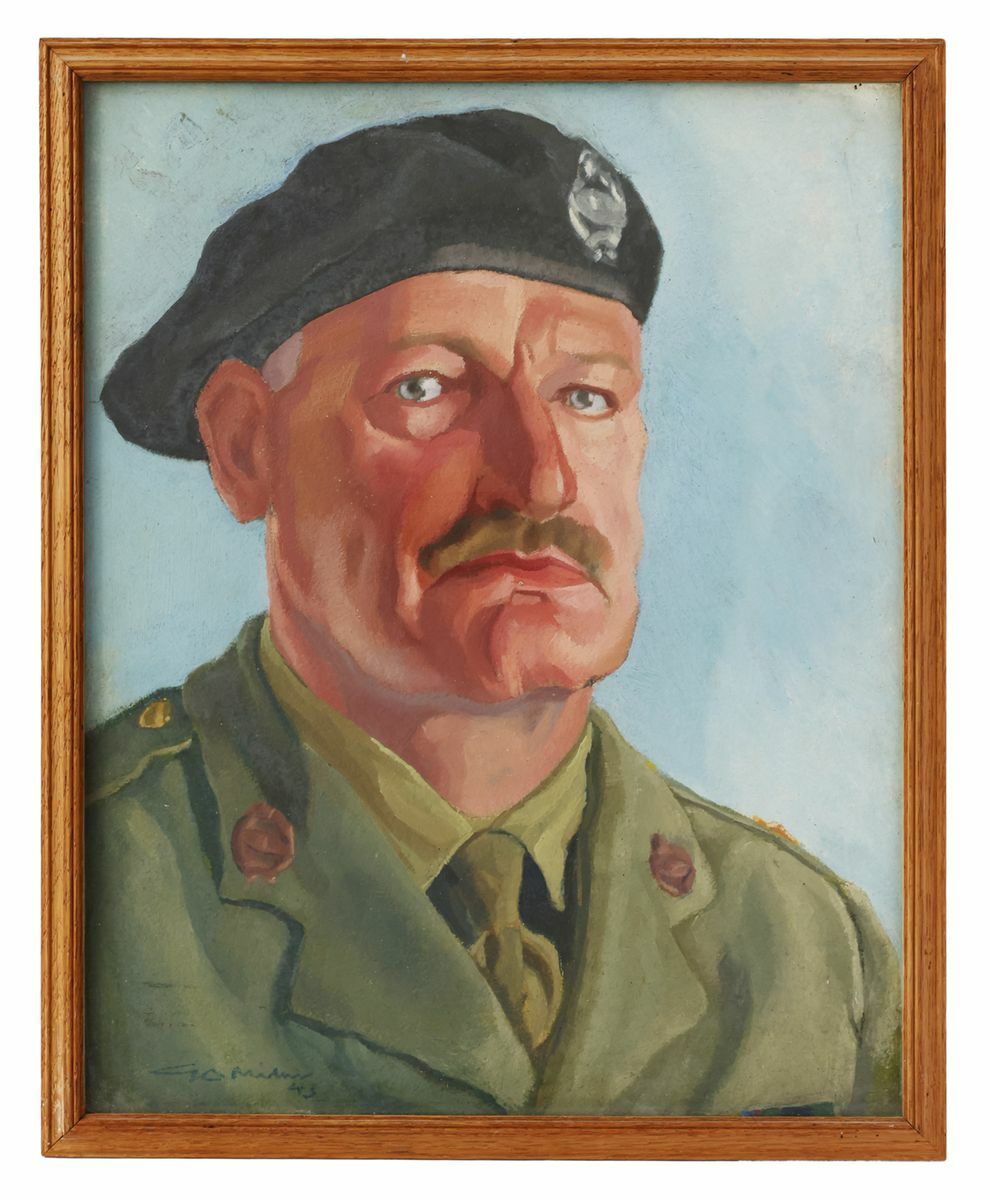Auction: 23002 - Orders, Decorations and Medals
Lot: 158
'Major King called me up and when I got to him, he [his tank] was on fire. His words were, "Doyle, let's finish the job." So, in again we went, knowing we were outnumbered, and never had a chance of coming out of it … Then the fun started. I know at least five German tanks he put out [of action] and a number of trucks, etc. You see we met a convoy, and did we have some fun! We paid Jerry back for the loss of the rest of the Company, and at about 8 o'clock, I saw him get hit in the front locker, but still he kept going. I myself was then on fire, but he must have been on fire for an hour or so. He would not leave his tank because we were surrounded by German tanks, etc., so we just kept on, letting them have it…'
Sergeant Doyle, D.C.M., of 'B' Company, 7th Royal Tanks, describes the extraordinary courage of his C.O. in what became known as the battle of Amiens, 21 May 1940.
'At this point a less gallant tank commander might have called it a day, and would have discreetly motored back to Vimy Ridge using Doyle's tank to cover his retreat. But King by this time appears to have turned his back on prudence. Perhaps he was still upset at the way his other tanks had been dealt with by the Germans, or perhaps he was just exhilarated by the heat of battle. Whatever the explanation, he rejected the chance to turn back and, like a man possessed, insisted on pushing on for one more action…'
Dunkirk - Fight to the Last Man, by Simon Sebag-Montefiore, refers.
A rare Prisoner of War portrait and related archive appertaining to Lieutenant-Colonel S. J. King, M.C. & Bar, Royal Tank Regiment, who performed prodigious acts of bravery in the crucial battle of Arras on 21 May 1940, when, as a Major and C.O. of 'B' Company, 7th Royal Tanks, he inflicted heavy loss on Rommel's 7th Panzer Division
The collection comprises:
(i)
A head and shoulders portrait in oils of Lieutenant-Colonel S. J. King, in uniform with beret, signed in the left-hand corner, 'G. D. Milne', and dated 1943, as executed by the artist at Oflag IX A/Z at Spangenberg, 15 by 12ins., framed and glazed
(ii)
A pencil sketch of King in his tank turret, with motto '50 Years of Progress!', signed in the right-hand corner, 'G. D. Milne', and dated 1942, the paper bearing an Oflag IX A/Z ink stamp, and the reverse bearing nine signatures of fellow prisoners, A4 size, onetime folded, unframed
(iii)
A watercolour drawing of a kitten in a tree, as painted by King at Oflag IX A/Z, postcard size, framed and glazed
(iv)
A copy of the book Oflag IX A/Z, edited by D. Guy Adams, Lt. Col., East Surrey Regiment (Frederick Muller, London, 1944), with inscription, 'S. V. Sutton, ex POW 74, Oflag IX A/H'; together with a copy of Young Art and Old Hector, by Neil M. Gunn (Faber and Faber, London), with pencilled inscription, 'Major S. J. King, No. 304', and ink Oflag stamp to inside cover
(v)
Four 1939-45 War postcards, three of them depicting Spangenberg castle, two of them with Oflag IX A/Z ink stamps, and the fourth a group photograph of officer P.O.W.s of the Royal Tanks; together with a small camp identity photograph of King, several Great War period postcards, and two large format images of King and fellow officers, circa 1918, these in card mounts
(vi)
King's draft letter and recommendation for the award of the M.M. to Corporal E. F. Holland, who was the driver of his Matilda tank in the Arras action in May 1940, as submitted by him on being repatriated in late 1943, pencil, 3pp., together with original War Office correspondence which includes a further recommendation for the award of the D.C.M. to Sergeant B. T. Doyle, also of 7th R.T.R.
(vii)
A signed report by Major-General D. H. Pratt, C.B., D.S.O., M.C., dated 5 November 1943, citing King's bravery on 21 May 1940. (Lot)
A note on the artist:
George Douglas Milne (1909-2005), the 2nd Lord Milne, was the only son of Field Marshal Lord Milne. A pre-war Territorial, he was wounded and taken P.O.W. on Crete in May 1941, while serving in the 51st Anti-Aircraft Regiment, R.A. He was subsequently incarcerated in Oflag IX A/Z at Spangenberg, a 13th century fortress near Kassel - now a luxury hotel - from which very few escaped.
A talented amateur artist, Milne formed an art club and taught other prisoners to paint, among them Lieutenant-Colonel King. Milne's mother dispatched painting materials by Red Cross parcel and, in 1944, he sent back a package of portraits of fellow inmates, drawn on strips of cardboard. Two of these were accepted for the Royal Academy summer show, and two more were displayed in The Daily Telegraph Prisoner of War exhibition, organised at Clarence House to raise funds for the Red Cross.
Described as 'a charming, sensitive man who was profoundly affected by his experience as a prisoner of war,' Milne was a prolific painter of portraits, landscapes and nude studies, exhibiting at the Royal Institute of Oil Painters and the Royal Society of Portrait Painters.
The Hero of Arras
Sydney John King first saw action as a subaltern in the Royal Field Artillery in France and Flanders in the Great War. His gallantry resulted in the award of the M.C. for 'a dangerous reconnaissance' (London Gazette 20 October 1916, refers), and a Bar to his M.C. for taking control of retiring infantry under heavy fire, and restoring the line, 'though himself blown off his feet by a shell' (London Gazette 19 November 1917, refers).
Remaining a regular soldier after the Great War, King transferred to the Royal Tank Corps, in which capacity he was mentioned in despatches for gallant and distinguished services on the North-West Frontier (London Gazette 6 May 1932, refers). He was also given the Brevet of Major in the same month.
And it was in the rank of Major that he assumed command of 'B' Company of the 7th Battalion, Royal Tanks in the battle of Arras on 21 May 1940. The actions of his battalion - and those of the 4th Royal Tanks - have since been recognised as having played a crucial role in delaying Rommel's advance, for he was convinced that his 7th Panzer Division was facing a British force much larger than it really was. At one stage in the battle, an exasperated Rommel was compelled to take personal charge of his anti-tank batteries.
On his repatriation in late 1943, presumably on account of wounds received near Arras, King submitted his official report on the action - a report widely quoted by military historians - together with forwarding recommendations for bravery awards to the above-mentioned Corporal Holland and Sergeant Doyle.
Astonishingly, no-one appears to have put King's name forward for like recognition, although an 'Interim Report' by Major-General D. H. Pratt, C.B., D.S.O., M.C., dated 5 November 1943, states:
'Major John King served as a Company Commander in the 7th Battalion, Royal Tank Regiment in the First Army Tank Brigade during the period I commanded the brigade. The dates approximately would be from October 1939 to 21 May 1940, when his tank unfortunately was set on fire by enemy action and, after a gallant fight, he was compelled with his crew to evacuate it.
Before going to France at the end of April 1940, during the training period, Major King worked to my complete satisfaction and was a most efficient Company Commander. On the 21st May he fought his tanks with conspicuous gallantry until, as stated, his own tank was set on fire. I regret I have not with me the eye-witness statements [of those] who are now prisoners of war but hope, in due course, to submit these, showing what a gallant action Major King put up before being overwhelmed near Arras.
I strongly recommend him for promotion in view of his experience and gallantry in action.'
King was duly promoted to Lieutenant-Colonel but he received no further recognition for his remarkable courage in May 1940, courage that was well worthy of an immediate D.S.O.
Subject to 20% VAT on Buyer’s Premium. For more information please view Terms and Conditions for Buyers.
Sold for
£300
Starting price
£240









